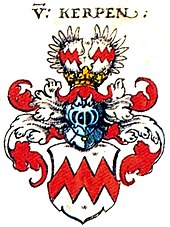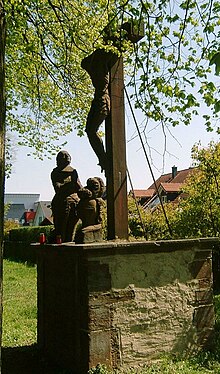Johann Walter von Kerpen
Johann Walter von Kerpen (* around 1602 ; † February 6, 1627 in Aschaffenburg ) was a member of the Order of Saint John of Jerusalem ( Johanniter , Rhodiser , Maltese ).
family
The von Kerpen , Kerppen, Karpen, Kärpen or Kirpin families were an old Rhenish ministerial family originally of noble origin. The headquarters were in the castle of the same name north of Daun in the Eifel . Otto von Kerpen was the second Grand Master of the Teutonic Order from 1200 to 1208. He died in 1208 and was buried in Acre .
Dietrich IV von Kerpen came to Saarland through his marriage to Geneta von Warsberg; his son Dietrich V. von Kerpen acquired the castle in 1359 and the rule of "Ildingen", an old property of the Counts of Saar Werden , from whom he had the castle as a fief.
Knight Johann Walter von Kerpen came from this line. His father was the Electorate Councilor and Truchseß Hans von Kerpen (1545–1611), Lord von Illingen and Fürfeld near Bad Kreuznach , his mother Claudia Freiin von Wiltz. She was the second wife, the first Anna von Schauenburg, the third wife was Anna von Kronberg, she came from the wing tribe of the Kronbergs and was related to the Mainz Elector - Archbishop , Johann Schweikhard von Kronberg (from the Kronberger Kronenstamm), the builder of Johannisburg Castle in Aschaffenburg.
siblings
- Stepbrother Daniel von Kerpen († 1631) was cathedral chapter in Fulda .
- Step-sister Ursula von Kerpen zu Illingen "Woman to Debt Castle" ⚭ Wolf Friedrich Kämmerer von Worms, called von Dalberg
- Johann Ludwig von Kerpen († 1654), Oberamtmann of the Electorate of Mainz in Lohr am Main , hunting master for the County of Rieneck , forester in Rothenbuch
- Heinrich Ernst von Kerpen (* around 1601 † before 1657), Stable Master of the Electorate of Mainz , Privy Councilor , chief hunter and chief magistrate in Amorbach
- Johann Friedrich von Kerpen, († 1631), cathedral capitular in Fulda, 1624 provost to St. Michael in Fulda and in Höchst monastery in the Odenwald and 1630 provost in Holzkirchen monastery near Würzburg .
- Philipp von Kerpen († 1635) member of the Mainz cathedral chapter and canon in Trier
- Anna Barbara von Kerpen ⚭ Philipp Christoph von Frankenstein
- Anna Maria von Kerpen ⚭ 1608 Friedrich von Fürstenberg-Herdringen (1576–1646)
- Maria Magdalena von Kerpen ⚭ 1613 Johann Christoph von Harstall
The Johanniter Komtur Heinrich Nikolaus Faust von Stromberg († 1621) was one of his relatives. Both great-grandfathers were brothers.
Life
Johann Walter von Kerpen joined the Order of St. John around 1620; his revolt took place on April 21, 1621 in Freiburg im Breisgau in front of the Grand Prior Johann Friedrich Hund von Saulheim , who presided over the chapter of the order and who was also attended by a grand ballroom officer . According to the rules of the German Order of St. John, he also had a pedigree certificate providing that at least sixteen noble ancestors should include. The rule of the order required a novitiate , at least five years of service in Malta at the court of the Grand Master and then participation in three "caravans" before the taking of the vows and final acceptance into the order. It is not known when the young Kerpen fulfilled these rules or whether he was granted special German rights. The representation in his family tree and on the memorial shows that he received military training and also held a military position. There a blond curly gentleman kneels, praying in front of a huge crucifix that seems to grow out of the lowest coat of arms (von Kerpen). His costume corresponds to that of an imperial officer in the Thirty Years' War , sword , spurs , the red sash worn over the shoulder (field band), a distinctive mark of the imperial and Spanish officers. His visor helmet , which is adorned with feathers in Kerpen's coat of arms (white-red-white), stands in front of the budding knight on the gloves that have been placed on the ground .
The Aschaffenburg council minutes report that “Kerppische Reutter” were quartered in Aschaffenburg under the leadership of a “captain lieutenant”.
The legend tells that in the winter of 1627 an ownerless horse, saddled, with loose reins and stirrups dangling to one side, ran over the Main Bridge through the open city gate. The noble steed trembled and foamed, and his eyes flickered with fear and horror. A search party followed the trail and, barely thirty minutes away, found the dead knight Walter von Kerpen in the corridor to the south-west near the “Nilkheimer grove”, and knelt beside him a squire and ruefully confessed his guilt. He and a few others had assassinated the knight. In the poem "A legend about the cross in the Busch-Allee in Aschaffenburg", the knight falls in love with the already engaged landlady Käthchen from the hostel "Zur güldenen Rose" in Stockstadt am Main , disregarding his vows . When the knight rides "into the forest to the gates of Aschaffenburg", Käthchen's fiancé lies in wait for him and in a duel he killed the rival who had fallen from his shy horse. Whether he wanted to come from Stockstadt that day, to see his brother in Amorbach, to come to Mosbach or at least to Aschaffenburg, has not yet been clarified.
His brothers Johann Ludwig and Heinrich Ernst had the body transferred to Lohr and buried in the local parish church .
monument
The von Kerpen brothers commissioned the sculptor Zacharias Juncker the Elder with an epitaph in the Lohr church and a memorial in Aschaffenburg.
The knight Johann Walter von Kerpen in armor kneels praying on a masonry base clad with sandstone slabs, life-size in front of a large cross with an equally life-size body , in front of which is the feather-adorned visor helmet. (Model: family tree)
The inscription on the Aschaffenburg monument base reads:
"Anno 1627, the 6th of February Varii was miserably and
accidentally murdered with four fatal shots by ......
, the Honorable and Wohledle Herr Iohan Walther von
Kerpen, St: Johannesordens Ritter in the 25th year of his Age.
Whose soul Almighty God wants to be merciful and merciful,
and all of his mournful lord brothers have for eternal
Gedechnus the shameful mortaht perpetrated on their dearest brother,
blessed by their dearest brother, had this epitaphive set up here in the
year 1628. "
The point marked with dots was forcibly made illegible soon after the monument was erected. It is believed that this part of the text contained the names of the murderers, whose families tried to erase any memory of the perpetrators of their relatives, which they have managed to this day.
In 1775 the monument, repaired by handicrafts by a bricklayer and partially renewed, was moved to the new avenue " Kleine Schönbuschallee ". Badly damaged in the French Revolutionary Wars, King Ludwig I commissioned the Würzburg sculptor Johann von Halbig (1814–1882) with the restoration in 1844 , while he is said to have reused the fragments of the knight's figure found.
While the plinth remained in place, the Aschaffenburg artist Otto Gentil replaced the figures with copies in 1931. In July 2013 the memorial (knight, helmet and cross) was deliberately badly damaged.
The original epitaph in the town church of Lohr is still preserved by Zacharias Juncker the Elder. The inscription reads:
"ADM (= Admirabili) RDO (= Reverendo) praenibili et generoso
heroi Joanni Waltero a Kerpen Dno in Illingen equiti melitensi proditory
a dvobus nefariis satellitibvs prope Aschaffenbvrgvm necato
6. Febrvarii ao 1627 et hic 12,
eg posverunt fratres. "
(“The admirable, venerable, noble and distinguished hero Johann Walter von Kerpen, Herr zu Illingen, Knight of Malta, who was treacherously murdered by two outrageous companions near Aschaffenburg on February 6, 1627 and buried here on the 12th of the same (month) out of affection this tomb erected by the sad brothers.) "
Below is the following epigram;
"Tevto fvi patria, proavis illvstris et armis
Ordine eques Melitae, evltor et imperii.
Corda dedit Mavors, Mvsa artes, signa Joañes,
Roma fidem, tvmvlŭ Lhora, Polvsque thronvm."
("I was a German, distinguished by ancestors and armed deeds, Knights of the Order of Malta and admirer of the empire. Mars gave me courage, artistry the muse, the standard Johannes, Rome the faith, the grave Lohr and heaven the throne.")
The church registers might have given information about what actually happened, but the first records of deaths begin in 1795. There are no fragments from previous times.
literature
Winfried von Borell Who was Johann von Kerpen? Aschaffenburg Yearbook for History, Regional Studies and Art of the Lower Maing Area Volume 11/12 Published by the Geschichts- und Kunstverein eV by Hans-Bernd Spies, Aschaffenburg 1988 ISBN 3-87965-042-X .
Web links
Individual evidence
- ↑ Caravans are called those expeditions by the Maltese knights, which they have to undertake on the water by means of the galeries again the infidels before they can get to the commanderies and other dignities of their order. Large complete universal encyclopedia of all sciences and arts (Zedlersches Lexikon) vol. 5, Halle / Leipzig 1733
- ↑ At “Schafheimer Straße”, that's what Martin Balduin Kittel calls the connection path to the wildlife park and further past Großostheim, towards Schaafheim (Hesse). It can be clearly seen on a contemporary map of the Battle of Dettingen (June 27, 1743). You can clearly see a cross on a pedestal, labeled “Kerpisch Creutz” Martin Balduin Kittel On Murder and Death Crosses , in: Erheiterungen Vol. 42 (1866) p. 302
- ↑ Tales of the Spessart collected by Adalbert von Herrlein . Published by AH Häcker I. Volume Verlag C. Krebssche Buchhandlung (W. Hausmann) Aschaffenburg 1906.
- ↑ Gustav Stoll A legend about the cross in the Busch-Allee in Aschaffenburg in Erheiterungen 37 (1861)
- ↑ Winfried von Borell who was Johann von Kerpen
- ↑ Christ and knight statues damaged - witnesses wanted. The knight's hands and face were cut off. Several notches were hammered into the Jesus figure. Main-Echo July 13, 2013
- ↑ http://www.epigraphica-europea.uni-muenchen.de/db/dia/6451.id ( page no longer available , search in web archives ) Info: The link was automatically marked as defective. Please check the link according to the instructions and then remove this notice.
| personal data | |
|---|---|
| SURNAME | Kerpen, Johann Walter von |
| BRIEF DESCRIPTION | Johanniter |
| DATE OF BIRTH | around 1602 |
| DATE OF DEATH | February 6, 1627 |
| Place of death | Aschaffenburg |




